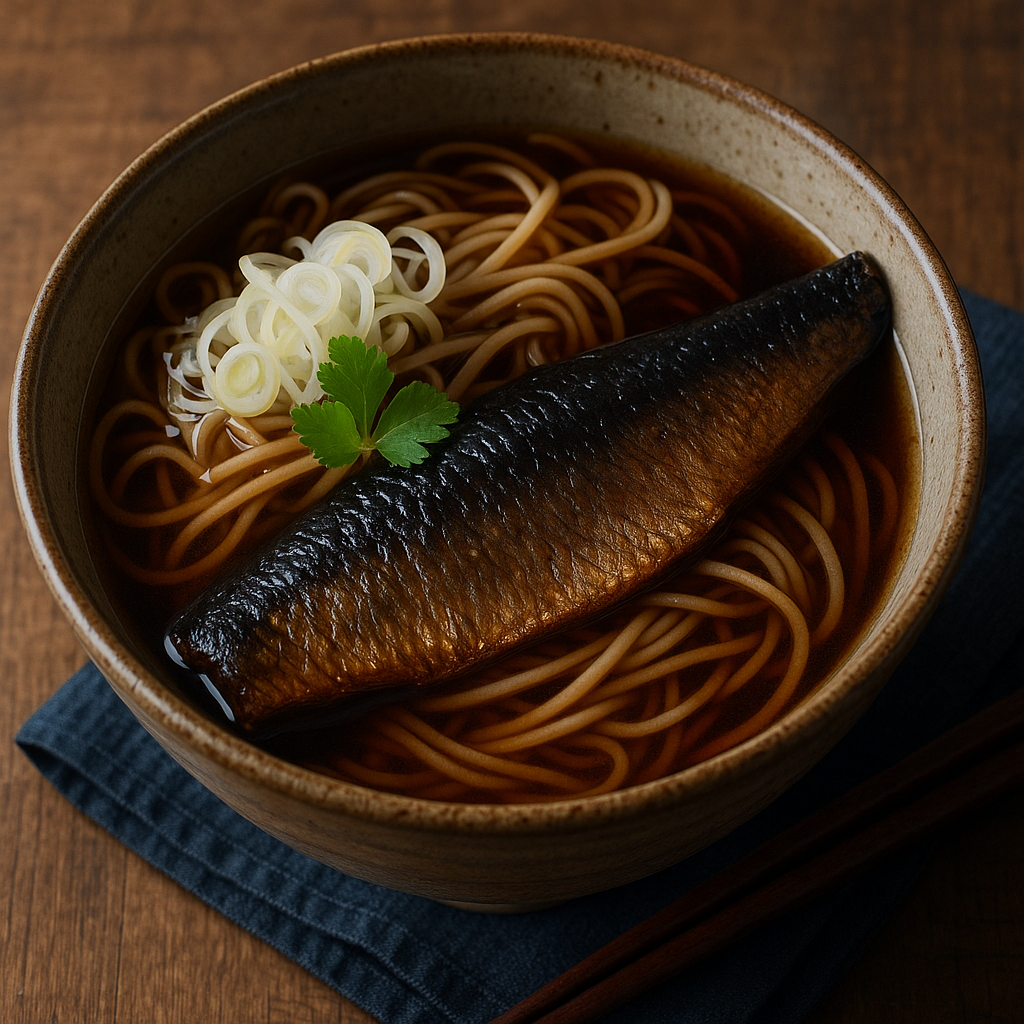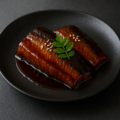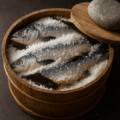ニシン蕎麦(北海道風)の特徴
北海道ならではの蕎麦料理
ニシン蕎麦は、本来京都の名物料理ですが、北海道でも独自に発展した郷土料理として親しまれています。甘辛く煮た身欠きニシンを蕎麦にのせ、旨味のしみ込んだ出汁とともに味わうのが特徴です。
甘辛い煮ニシンと蕎麦の調和
醤油・砂糖・みりんでじっくり煮込んだニシンの旨味が蕎麦つゆに溶け込み、滋味深い味わいが楽しめます。骨まで柔らかく煮込むことで、食べやすさも増します。
冬の定番メニュー
北海道の寒い冬に体を温める料理として定着しており、家庭や蕎麦店で広く楽しまれています。
ニシン蕎麦(北海道風)のレシピ
材料(2人分)
- 乾麺そば … 2人分
- 身欠きニシン(甘露煮または煮付け済み) … 2切れ
- 長ネギ … 1/2本
- だし汁 … 500ml
- 醤油 … 50ml
- みりん … 40ml
- 砂糖 … 大さじ1
作り方
- 鍋にだし汁・醤油・みりん・砂糖を入れて加熱し、蕎麦つゆを作る。
- 蕎麦を表示通りに茹でて、水で締める。
- 長ネギを斜め切りにし、つゆで軽く煮る。
- 丼に蕎麦を盛り、温めたニシンの甘露煮をのせ、つゆを注ぐ。
- ネギを添えて完成。
シェフのワンポイントアドバイス
身欠きニシンは市販の甘露煮を使うと簡単ですが、自家製で煮るとより深い味わいになります。
蕎麦つゆに少し山椒を加えると、香りが引き立ちます。
京都のニシン蕎麦よりも北海道風のニシン蕎麦は甘みが強めなので、好みで砂糖を加えてください。
ニシン蕎麦(北海道風)の栄養価(1人分の目安)
- エネルギー:約400〜500 kcal
- たんぱく質:20〜25 g
- 脂質:8〜12 g
- 炭水化物:60〜70 g(蕎麦由来)
- カルシウム(ニシン由来)
- ビタミンB群(魚・蕎麦由来)
- 食物繊維(蕎麦由来)
炭水化物・たんぱく質・カルシウムを同時に摂取できる栄養バランスの良い一品です。
ニシン蕎麦(北海道風)の歴史
京都発祥から北海道へ
ニシン蕎麦は江戸時代に京都で生まれた料理ですが、北海道でも身欠きニシンの産地であることから広まりました。
保存食としての身欠きニシン
北海道では保存食である身欠きニシンを活用し、蕎麦と組み合わせることで冬の栄養食として定着しました。
郷土料理としての定着
現在では蕎麦店や家庭で提供され、北海道風にアレンジされたニシン蕎麦として広く親しまれています。
English Version
Features of Hokkaido-Style Nishin Soba
A Unique Soba Dish from Hokkaido
Nishin Soba, originally a specialty of Kyoto, has also developed uniquely in Hokkaido as a beloved local dish. Sweet and savory simmered dried herring (migaki nishin) is placed on soba noodles and enjoyed with a flavorful broth infused with its umami.
Harmony of Simmered Herring and Soba
The herring is simmered slowly in soy sauce, sugar, and mirin, allowing its deep umami to blend into the soba broth. Cooking it until the bones are tender makes it easier to eat and enhances the flavor.
A Winter Comfort Dish
In Hokkaido, it has become a staple winter meal, warming both body and soul, and is widely enjoyed at home and in soba restaurants.
Recipe
Ingredients (for 2 servings)
- Dried soba noodles … 2 servings
- Migaki nishin (sweet-simmered or pre-cooked herring) … 2 pieces
- Leek (naganegi) … 1/2 stalk
- Dashi broth … 500 ml
- Soy sauce … 50 ml
- Mirin … 40 ml
- Sugar … 1 tbsp
Instructions
- In a pot, combine dashi, soy sauce, mirin, and sugar to make the soba broth.
- Cook soba noodles according to package instructions, then rinse under cold water and drain.
- Slice the leek diagonally and lightly simmer it in the broth.
- Place the noodles in a bowl, top with warmed simmered herring, and pour the broth over.
- Garnish with leek and serve.
Chef’s Tip
Using store-bought sweet-simmered herring makes preparation easy, but homemade simmered herring provides a deeper flavor. A touch of sansho pepper in the broth enhances its aroma. Compared to Kyoto-style Nishin Soba, the Hokkaido version tends to be sweeter, so you may adjust the sugar to your preference.
Nutritional Value (per serving, approx.)
- Calories: 400–500 kcal
- Protein: 20–25 g
- Fat: 8–12 g
- Carbohydrates: 60–70 g (mainly from soba)
- Calcium (from herring)
- B vitamins (from fish and soba)
- Dietary fiber (from soba)
This dish offers a well-balanced source of carbohydrates, protein, and calcium in a single bowl.
Historical Background
From Kyoto to Hokkaido
Nishin Soba originated in Kyoto during the Edo period, but spread to Hokkaido due to its role as a major producer of dried herring (migaki nishin).
Use of Preserved Herring
In Hokkaido, preserved dried herring was combined with soba as a nourishing winter dish, making use of its long shelf life and rich flavor.
Established as a Local Cuisine
Today, it is commonly served in soba shops and homes, recognized as a uniquely Hokkaido-style variation of Nishin Soba.



何でも質問してください!